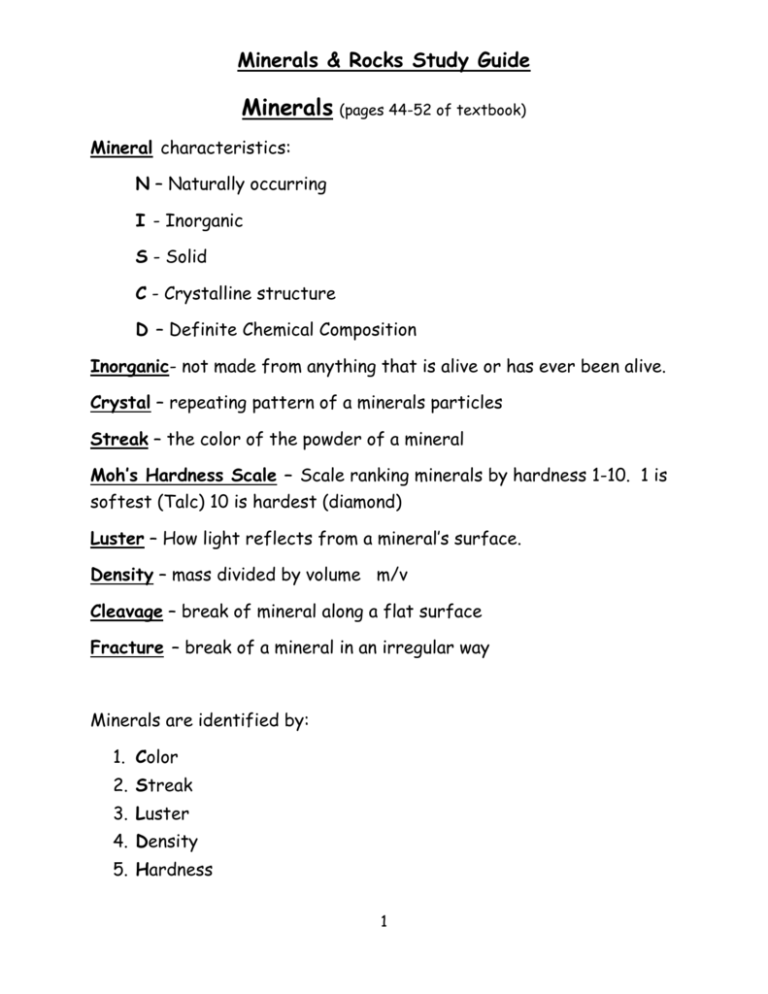Minerals and Rocks Study Guide
advertisement

Minerals & Rocks Study Guide Minerals (pages 44-52 of textbook) Mineral characteristics: N – Naturally occurring I - Inorganic S - Solid C - Crystalline structure D – Definite Chemical Composition Inorganic- not made from anything that is alive or has ever been alive. Crystal – repeating pattern of a minerals particles Streak – the color of the powder of a mineral Moh’s Hardness Scale – Scale ranking minerals by hardness 1-10. 1 is softest (Talc) 10 is hardest (diamond) Luster – How light reflects from a mineral’s surface. Density – mass divided by volume m/v Cleavage – break of mineral along a flat surface Fracture – break of a mineral in an irregular way Minerals are identified by: 1. Color 2. Streak 3. Luster 4. Density 5. Hardness 1 Minerals & Rocks Study Guide 6. Special properties (magnetism, glowing under ultraviolet light, doubles images, reaction to acids) Rocks (pages 54-72) Rocks are made up of minerals, soil, and sometimes even organic materials. Geologist study a rock’s mineral composition (what minerals are in it), color and texture (the look and feel of its surface which is a result of the size and shape of its grains-particles). Rock forming minerals – common minerals that make up most of the rocks on the Earth. Rocks are classified by how they are formed. There are 3 classifications of rocks: igneous, sedimentary and metamorphic. 1. Igneous rocks Formed from cooling of molten rock Classified by origin (where they form),texture, and minerals composition Intrusive igneous rocks- cool inside the earth’s surface (larger grained crystals) Extrusive igneous rocks – cool outside the earth’s surface(smaller grained crystals) Igneous rocks that are have very little Silica (oxygen and silicon mixture) are lighter in color than those with more silica. Basalt is a darker igneous rock that usually found in or on oceanic crust. Granite is lighter colored igneous rock that is usually found in or on continental crust. 2. Sedimentary rocks Formed from Deposition, Compaction and Cementation of sediments (small pieces of rocks and soil) 2 Minerals & Rocks Study Guide Clastic sedimentary rocks – formed when rock pieces are squeezed together Organic sedimentary rocks – formed when remains of plants and animals are deposited in thick layers Chemical sedimentary rocks – formed when minerals are dissolved in a solution and crystalize 3. Metamorphic rocks Formed when sedimentary or igneous rocks are under extreme heat and pressure deep underneath the Earth’s surface. Foliated – grains arranged in parallel layers and bands Non-foliated – grains arranged randomly Common metamorphic rocks that from by heat and pressure from other rocks are: - Granite (igneous) changes to Gneiss (metamorphic) - Igneous Rock (Magma cooling) Sandstone(sedimentary) changes to Quartzite (metamorphic) Shale (sedimentary) changes to Slate(metamorphic) Sedimentary Rock (Deposition, compaction Metamorphic Rock (heat & pressure) & cementation) Types Types Types Non- Intrusive Extrusive Clastic Organic 3 Chemical Foliated Foliated Minerals & Rocks Study Guide Rocks are broken down by: 1. Melting - heat turns rocks into liquid molten rock called magma 2. Weathering - wearing down of a rock turning it back into sediment Mechanical weathering--- rocks physically broken Chemical weathering ---breaking down of rock by a chemical changes 3. Erosion – the movement of rocks and soil caused .by humans, animals, or weather. . Rock Cycle: a slow process that builds, destroys and changes rocks. It can change rocks from one kind to another kind of rock. 4







